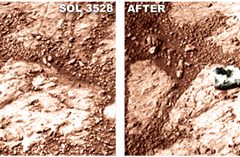According to space.com, after a decade of exploring the Martian surface, the scientists overseeing the rover Opportunity thought they’d seen it all. That was until a rock mysteriously appeared a few feet in front of the six-wheeled rover.
News of the errant rock was announced by NASA Mars Exploration Rover lead scientist Steve Squyres of Cornell University at a special NASA Jet Propulsion Laboratory “10 Years of Roving Mars” event at the California Institute of Technology in Pasadena, Calif. The science star-studded public event was held in celebration of the decade since twin rovers Spirit and Opportunity landed on the red planet in January 2004.
While chronicling the scientific discoveries made by both rovers over the years, Squyres discussed the recent finding of suspected gypsum near the rim of Endeavour Crater – a region of Meridiani Planum that Opportunity has been studying since 2011 – and the discovery of clays that likely formed in a pH-neutral wet environment in Mars’ past.
While these discoveries have been groundbreaking, Squyres shared the Mars rover’s team’s excitement for that one strange rock, exclaiming: “Mars keeps throwing new stuff at us!”
In a comparison of recent photographs captured by the rover’s panoramic camera, or Pancam, on sol 3528 of the mission, only bare bedrock can be seen. But on sol 3540, a fist-sized rock had appeared (see photo). MER scientists promptly nicknamed the object “Pinnacle Island.”
“It’s about the size of a jelly doughnut,” Squyres told Discovery News. “It was a total surprise, we were like ‘wait a second, that wasn’t there before, it can’t be right. Oh my god! It wasn’t there before!’ We were absolutely startled.”
But the rover didn’t roll over that area, so where did Pinnacle Island come from?
Only two options have so far been identified as the rock’s source: 1) The rover either “flipped” the object as it maneuvered or 2) it landed there, right in front of the rover, after a nearby meteorite impact event.
So my best guess for this rock … is that it’s something that was nearby,” said Squyres. “I must stress that I’m guessing now, but I think it happened when the rover did a turn in place a meter or two from where this rock now lies.

